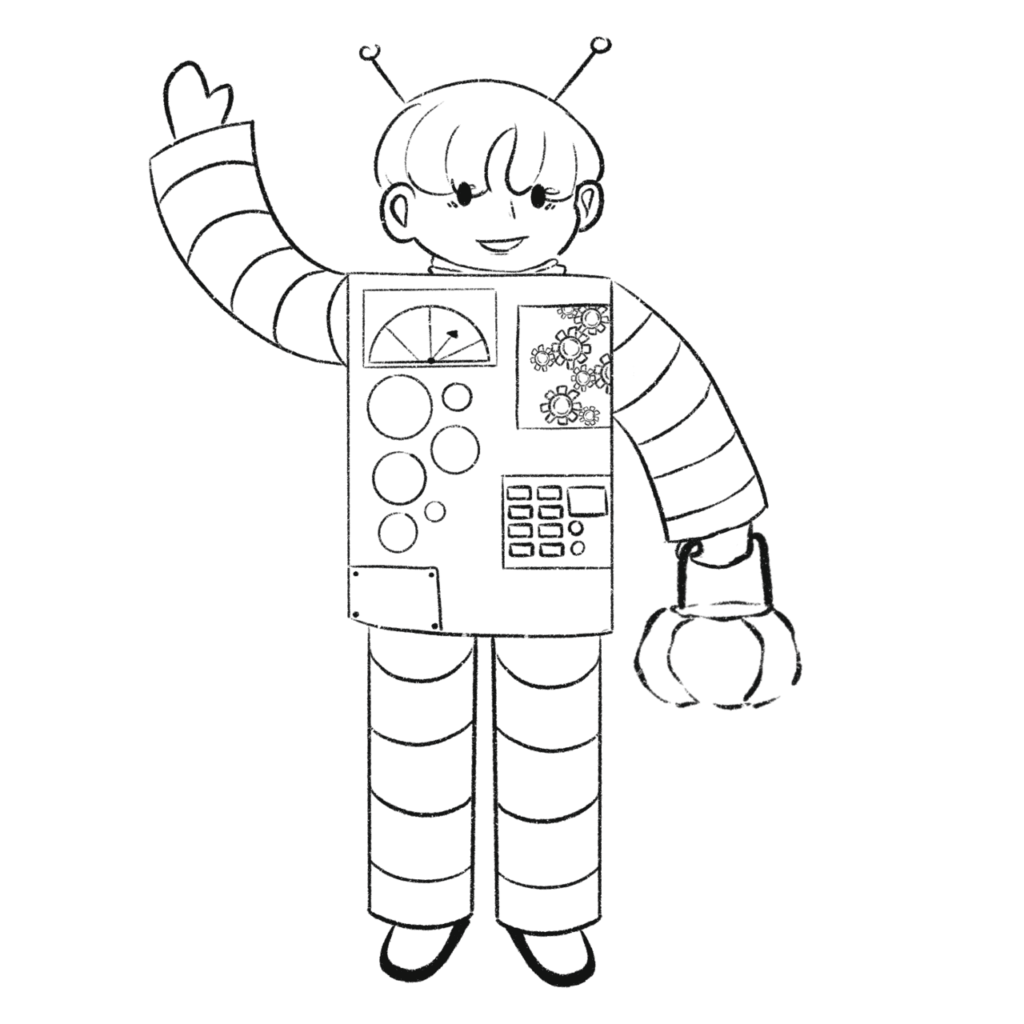Challenge your students to communicate their reasoning and demonstrate their critical thinking as they solve these constructed response math problems related to Halloween costumes.
Kindergarten – 2nd Grade:
Ask your students to color the image, then answer the questions as a class.

1. How many circles are part of the costume?
2. What other shapes are included in the costume?
3. Billy’s mom made the costume. She used 10 feet of flexible tubing to create the legs and arms. She used 6 feet of the tubing on the legs. How much tubing is needed for 1 arm? Use words and numbers to support your answer.
3rd – 5th Grade:
1. A simple ghost costume (bedsheet with two eye holes cut out) is a long time favorite. How many eye holes need to be cut out to make enough ghost costumes for everyone in your class? Use words and numbers to support your answer.
2. Traditionally, Halloween costumes were made at home and rarely purchased from a store. Kevin’s aunt is making his Halloween costume (a robot). She spent $5.50 on fabric, $8 on decorative items (beads, dials, reflective tape, etc.). A robot costume in the store cost $28. How much money did Kevin’s aunt save by making the costume rather than purchasing it from a store? Use words and numbers to support your decision.
3. Table 1 tells the amount of time needed to make each costume.
Kevin’s aunt made him a robot costume. She also made 2 astronauts and 4 octopus costumes. How many hours did she spend working on the costumes? Use words and numbers to support your answer.
6th – 8th Grade:
Use the following information about buying fabric to help you answer the questions.
- Fabric from a store it is sold by the yard (yes you can request ¼, ½ and ¾ yard)
- The fabric has a width of either 36, 60 or 72 inches
1. Molly is making herself a costume. The skirt needs to be 28 inches around and 30 inches in length. The top needs a total of 700 square inches of the same fabric. The fabric has a width of 60 inches. How many yards of fabric should Molly get? Justify your answer.
2. Mateo needs a total of 9 feet of fabric to create his vampire costume. The fabric has a width of 72 inches, and he purchased 3 yards of fabric. Did Mateo purchase the correct amount of fabric? Justify your answer.
3. Paul has a budget of $12 to make his Halloween costume. He spent $4 on make-up and props. He needs to purchase his fabric to make a cape. He has not decided upon how big the cape must be but it needs to be at least 2.5 feet wide and preferably greater than 3 feet long. He has two options of fabric that he likes. Option 1: cost $8 per yard and has a width of 72 inches. Option 2: cost $6.50 and has a width of 60 inches. Which fabric option do you recommend and how much money would Paul have left to make other purchases? Justify your answer.
High School:
1. Luke is making a robot costume for his little brother. Luke is using flexible tubing to create the arms and legs of the robot costume. His brother stands 42 inches tall, his legs are 21 inches long and his arms are 18 inches long. The tubing is sold in 4-, 6- and 8-feet sections. You cannot purchase anything less than 4 feet. Luke claims that a 6-foot section is sufficient and that the lack in length will not be noticeable overall. Do you agree or disagree with Luke’s claim? Justify your decision. Justify your answer.
2. Gina is making a monster costume for her cousin. The head is 20 inches wide and 24 inches tall. She is adding spikes to 60% of the head. Each spike has a diameter of 3 inches. How many spikes should she make? Justify your answer.
3. Lily is making costumes for children in her neighborhood. There are 200 children in her neighborhood. Table 1 provides information about each type of costume.
What is Lily’s hourly pay rate if she successfully makes and sells all of the possible costumes for her neighborhood? Justify your answer.


